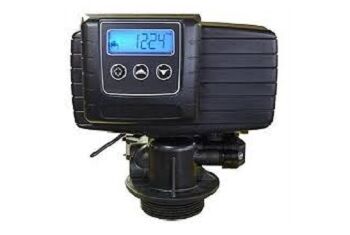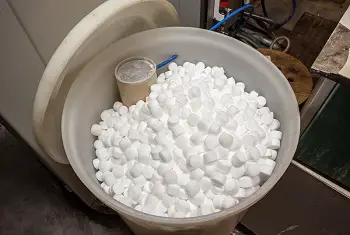You have had your new water softener for a few months now but have never actually heard it operating. You go down by your water softener and hear it making some sounds, but are these sounds the sound that it is supposed to be making? What does a water softener regeneration sound like?
A water softener regeneration will make sounds of water flowing slowly and at a fast rate as well as motorized sounds if the water softener functions with an electric motor. A non-electric water softener may make clicking sounds as the gears and impellers move inside the water softener valve.
There are different sounds to each of the cycles during regeneration and not all water softeners sound the same. The sounds that a water softener will make will depend on the brand, model, and how it is programmed. Some electric water softeners can be programmed to regenerate in different cycle combinations.
Different water softener cycles and what they sound like.
Brine fill:
Some water softeners use a “dry brine tank” regeneration process which leaves the brine tank empty after the regeneration process.
This means that the water softener has to add water to the brine tank towards the beginning of the regeneration cycle so that the water will dissolve the salt from the brine tank to make the brine that is needed to regenerate the water softener resin inside of the water softener.
This is often the last cycle of the regeneration process on standard water softeners but is the first cycle when the water softener is programmed to leave the brine tank empty after the regeneration process and only lasts a few minutes depending on the salt dosage that the water softener requires.
The sound that you will hear during the brine fill cycle sound just like a small hose filling a plastic bucket because that is exactly what is happening.
A small tube is putting water into the brine tank that has been empty since the last regeneration cycle.
After a few minutes, the brine fill sound will stop and there should be absolutely no sounds coming from your water softener for several hours as the water sits in the brine tank and slowly dissolves the salt from the tank.
First backwash:
Many electric water softeners will perform an initial backwash to run water backward through the water softener tank. This reverse flow of water is to remove sediment and debris from the top of the resin bed and to fluff up the resin so it is not packed tightly together when the water softener draws the brine (saltwater from the salt tank) through the resin.
This “fluffing” backwash requires a strong flow of water so it makes a noticeable rushing of water sound. In many cases, the water will be flowing backward through the water softener tank much like the flow of water from a sink at full flow.
This first backwash is often one of the loudest cycles of the whole regeneration process but usually is over in 10 minutes or less.
Brine draw:
This is normally the longest cycle of the water softener regeneration process by far but is also one of the quietest cycles. There is a medium flow of water going through the water softener that is drawing the brine from the brine tank with it.
This cycle is not as loud as a backwash cycle because the brine has to be allowed to remove hard ions from the water-softener resin through the process of ion exchange.
This is the process where the water softener is getting rid of the hardness that it has already removed from your water so that it can continue to remove more hardness from your water.
Brine Rinse:
Once the water softener has completed its brine draw cycle to regenerate the water softener resin, the water softener will run a medium flow of clean water over the water softener resin to rinse away the majority of the brine that was used to regenerate the water softener resin.
The sound of the brine rinse cycle is often about the same as the brine draw cycle. It is not usually very loud but may last for as much as 30 minutes depending on how your water softener is programmed.
Second Backwash:
This is where your water softener will start to make the loud sound of rushing water again. Much like the first backwash cycle, there will be a very strong flow of water going through the water softener to remove as much of the leftover sodium from the water softener resin and to re-fluff the resin so that it regenerates evenly during the next regeneration cycle.
Although this cycle is rather loud, it is often just a short cycle that may last as few as 5 – 10 minutes, but can be set to last longer.
Fast Rinse/ Settling rinse:
This is a loud but short cycle (sometimes as little as 2 minutes) where the direction of water goes the same direction as the water normally flows through the water in between regenerations but the water flows at a very high rate to settle the water softening resin back down into the tank after it has been fluffed-up by the reverse flowing water of the backwash cycle.
Essentially, this fast rinse cycle is packing the water softener resin back down into the tank so it is ready to remove more hardness from your water.
Brine Re-fill:
Most water softeners still use a “WET” brine tank method. This is where the water softener puts water into the brine (salt) tank at the end of the regeneration process so the water sits in the tank until it is needed for the next regeneration.
This is a rather quiet cycle because it is just water coming out of the brine tube and going into the brine tank. You can usually hear the water filling for just a short while until the water gets to the correct level in the tank.
Check out this quick video on water softener cycles and what they do.
What sounds to expect with different regeneration processes?

An electric water softener uses an electric motor to control the different cycles that the water softener goes through for the regeneration process so you will likely hear a humming type noise before and after each cycle as the electric motor drives the mechanical parts inside of the control valve.
A non-electric water softener uses gears and valves to control the regeneration cycles which do not make much sound so you may not hear the changes in regeneration cycles as easily.
Two-cycle water softener regeneration sounds.
Most commonly used in non-electric water softeners or backwashing filters, the first cycle will most likely be a fast backwash cycle that will sound like a strong flow of water flowing through the water softener and there will be a fast flow of water going out of the drain line.
This will be relatively loud on an electric backwashing filter but not as loud on a non-electric water softener.
The second cycle might be much quieter than the first on an electric backwashing filter if the second cycle is just a settling rinse and the sound may stay virtually the same on a non-electric water softener because the water flow of the brine rinse cycle will stay almost the same as the first brine draw cycle.
Three-cycle water softener regeneration sounds.
A standard water softener using just three cycles will have a relatively short (10 minutes or so) but loud first backwash cycle followed by a longer but much quieter brine draw cycle of up to 90 minutes and then a final backwash cycle that will sound very much like the first backwash but normally shorter (5 minutes or less).
A non-electric water softener may use only three cycles on some models and all three cycles will sound pretty much the same.
They will start with a brief medium flow backwash followed by a longer brine draw cycle and then finish with a short backwash all at very much the same flow of water so the sound of the different cycles will sound relatively quiet and almost the same.
Four-cycle water softener regeneration sounds.
I find that this is the most common number of cycles on most brands of water softeners.
Most water softeners only require 4 cycles to properly regenerate their water softener resin and continue to remove hardness from your water.
You will find four stages on a few non-electric water softeners, but this is not very common and the cycles will all sound basically the same.
This is certainly not the case with the four cycles of a standard electric water softener.
A four-cycle regeneration will often sound more like a three-cycle regeneration because the last two cycles may sound very similar.
On an electric water softener using four regeneration cycles, you will usually find the first cycle to be a loud backwash to fluff up the water softener resin and rinse away any debris that has found its way into the water softener tank.
This will be a strong flow of water that may last up to 10 minutes or so depending on how your water softener is programmed.
After the loud first backwash has ended, the brine draw cycle will draw brine for up to 90 minutes but the sound of this cycle is much quieter than the first backwash cycle.
The third cycle in a standard four-cycle regeneration process is generally a second backwash which rinses away the brine from the water-softener resin and re-fluffs the water-softener resin, preparing it for removing more hardness from your water.
This is usually just as loud as the first backwash, but in most cases, this second backwash is shorter than the first.
The fourth cycle is usually a very quick but loud settling rinse to settle the water softener resin down into the tank before putting the water softener back into the service mode where it removes the hardness from your water.
Most water softeners finish with a brine refill.
In most cases, the final cycle for a water softener will be a relatively short and quiet brine refill cycle where the water softener is putting water into the brine tank to prepare for the next regeneration.

After these cycles are complete, the water softener should go to its in-service mode where it should become silent other than the sound of water flowing through the tank when you are using water in your home.
If your water softener is making a sound long after its regeneration process is complete, there could be water getting past the water seals inside of the control valve, or the water softener may have gotten stuck in one of its regeneration cycles.
If this happens, bypass your water softener to stop water flowing through it until you determine the problem, or contact your water softener professional.

